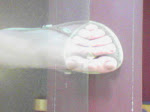One week prior to my departure for Buenos Aires, someone, somehow, wields a replica of my debit card and charges over $200 at a Walmart. Because I opened the bank account moons and moons ago in Maine, the only way my bank will issue me a temporary debit card is if I get a new, California-based account. I wonder, as my money vanishes into limbo, if this disaster in miniature is an omen or a cleansing.
My day of departure begins with a good deed. My coproducer on the musical I wrote drives to the Valley from Venice to drive me to LAX. For those of you who don’t know the geography of Los Angeles, I owe her. On the ride, we talk lyrics and the phenomenon that is District 9, a film that’s a parable of apartheid, with blacks played by aliens—yet it’s not racist like Transformers 2. We talk marketing and actors we hate and don’t hate.
My gate is next to the one departing for Kona, and two groups of Texans are chatting loudly and congenially. One, an older man wearing a Hawaiian shirt, spills chocolate ice cream on his white trousers, and everyone guffaws good-naturedly. The man vows to continue wearing white trousers despite himself.
On the flight to Mexico City is a young man who looks like Eric Bana. I immediately wish I was more attractive, sitting next to him, and able to speak better Castellano. I’m already feeling my poor grasp of the language and when, the food comes, afraid that my dislike of pork will be equally as problematic.
The cloud cover over Mexico City just before 7:00 pm is gorgeous. Volcanic white meringue as far as the eye can see. Canyons and plains and hills of soft sculpted cumulus. We dive down and it is a different story. The city is gray and it is raining. Apparently there was some nimbus to that cumulus. The avenidas are tree-lined, the buildings charming with brick red roofs. We land. I see a hangar for Aeromar with its strange half-erased font.
Over four hours in the airport waiting for a gate to be assigned to my flight to Buenos Aires. I have no idea what the peso-dollar exchange rate is and wonder how much the 117 pesos I just spent on Vanity Fair and a postcard will translate to on my credit card bill. I wander the airport, which is practically empty compared to LAX, and extremely clean. The shops are smaller than any I’ve seen before, but other than that it is one of the most appealing airports I’ve seen. Starbucks and Carl’s Jr. startle me, though I don’t know why. I listen to some recently downloaded Red Hot Chili Peppers, watch an episode of The State on my laptop, put on my blazer, and wait. And wait. And wait.
Finally, the plane. Luckily, I get a whole row to myself, but I am too tall to lie down on the three seats and be comfortable. I try to watch Australia, but I am simply too tired, and there's something a bit trippy about it. In the morning, we leave the Pacific, cross over Chile and the snow-frosted Andes, and finally taxi into Ezeiza.
I take money out of the ATM at the bank outside the terminal, then take a taxi to Palermo. My friend is staying in a doorman-fronted apartment building in a little loft with an extremely comfortable futon couch. The water pressure in the shower is strong. I cannot ask for more.
The first thing I notice in Buenos Aires is that there are no stop signs. This is not because there are stoplights at every intersection or some other kind of sign. Cabs, buses, cyclists, and Renaults vie for right of way at all non-major intersections of Buenos Aires. Pedestrians are always bottom of the food chain.
Should you dodge death when you cross the street, you are not yet safe. The sidewalks of Buenos Aires are, almost universally, topographically dangerous. Hunks of cement and tile have been torn out as if commissioned by physical therapists in want of twisted ankles to mend. Only Puerto Madero, young and underpopulated, seems immune. Nowhere, though, is fully immune to the dogs. Though seen everywhere people have residences in the city, dogs are particularly plentiful in Palermo. Buenos Aireans walk their dogs, thankfully, but they do not clean up after them. If you manage to find a stretch of flat, passable sidewalk, it is bound to have excrement willy-nilly.
So ends the negatives. For Americans, particularly city-dwellers used to exorbitant prices, Buenos Aires is quite cheap. No, you can’t get tap water, and, yes, they charge a “sitting fee” at some restaurants, but the subway is cheap and safe, the food is cheap, expected tip is 10%, museums are cheap or free, parks and gardens are free and plentiful, and the only truly costly thing here is fine leather and the occasional top-shelf hotel. The rest of the time, you feel like you’re ripping Argentina off.
I'll tell you specifically where I went and what I did in later posts.
Monday, September 7, 2009
Subscribe to:
Post Comments (Atom)
In summing up, I wish I had some kind of affirmative message to leave you with. I don't. Would you take two negative messages?
-- Woody Allen

No comments:
Post a Comment